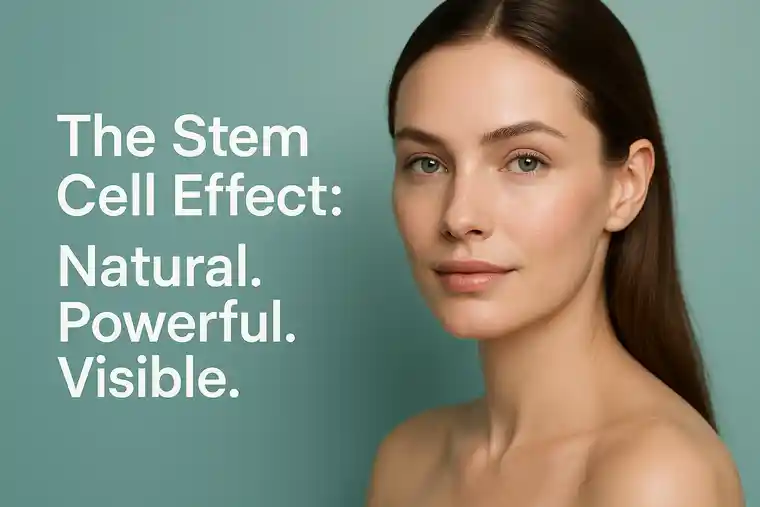by Dr. Deniz Kök
When the Skin Whispers the Story of Time
As a physician, I have always seen the skin not merely as a cosmetic façade, but as an eloquent storyteller. It reveals not only the passage of years but also the burdens of stress, environmental aggression, metabolic imbalances, and inflammatory processes that silently erode our well-being.
While aging is an inevitable biological journey, premature skin aging is often the visible symptom of systemic imbalance, not destiny.
Throughout my career, I have welcomed patients who were not in pursuit of vanity, but vitality. They sought not superficial youth, but a deeper renewal — a skin that tells a story of inner harmony, resilience, and health.
This is where stem cell and exosome therapies converge as a new frontier in regenerative dermatology — not to erase the signs of time, but to awaken the skin’s inherent ability to repair, recalibrate, and rejuvenate.
Why the Skin Ages — And the Hidden Mechanisms Beneath
Skin aging is not an overnight occurrence. It unfolds as a gradual, multifaceted decline fueled by ultraviolet exposure, pollution, nutritional deficits, hormonal shifts, chronic stress, and oxidative wear.
- Breakdown of collagen and elastin fibers — leading to laxity and wrinkles
- DNA damage from oxidative stress
- Sluggish cell turnover — resulting in dull, uneven texture
- Impaired microcirculation — depriving skin of oxygen and nutrients
- Inflammaging — a state of chronic, low-grade inflammation accelerating tissue fatigue
- Dermal thinning and fragility
These mechanisms translate visibly into fine lines, sagging, dryness, hyperpigmentation, redness, and a fading luminosity that no topical cream can truly restore.
The Regenerative Symphony: How Stem Cells and Exosomes Work

Stem Cells: The Master Conductors
MSCs act as the conductors of a cellular orchestra, releasing bioactive signals that instruct skin cells to repair, rebalance, and regenerate. They engage directly with:
- Fibroblasts — to boost collagen and elastin production
- Endothelial cells — to revitalize microcirculation
- Immune cells — calming inflammation and restoring tolerance in sensitive skin
Exosomes: The Precision Messengers
Exosomes are nano-sized vesicles naturally secreted by stem cells, carrying a payload of growth factors, microRNAs, lipids, and peptides that deliver regenerative instructions deep into the skin’s microenvironment. They serve as amplifiers and accelerators of skin repair, ensuring targeted action even in delicate or compromised skin.
Key Biological Benefits
- Stimulate collagen and elastin synthesis
- Boost hyaluronic acid and skin hydration retention
- Improve microvascular perfusion
- Quench oxidative stress and UV-induced damage
- Dampen chronic inflammatory processes (Inflammaging)
- Enhance skin barrier integrity
- Foster dermal thickness and structural resilience
Scientific Validation: Evidence Over Hype
- Park YJ et al. (2021) demonstrated that topical MSC-derived exosomes improved texture, hydration, and wrinkle depth in women over 40. PubMed: 33620383
- Kim YS et al. (2020) found that intradermal MSC injections enhanced elasticity, dermal density, and reduced wrinkles after three sessions. PubMed: 32940418
- Lee S et al. (2022) reviewed exosome therapies noting superior skin density, moisture retention, and reduction of inflammatory biomarkers. PubMed: 35197014
Who Can Benefit?
- Individuals with visible skin aging (wrinkles, sagging, dull tone)
- People with sensitive, inflamed, or rosacea-prone skin
- Post-laser or post-surgical patients seeking accelerated recovery
- Those battling chronic skin inflammation and barrier dysfunction
- Individuals seeking natural alternatives to Botox or fillers
- Proactive individuals aged 35+ prioritizing long-term skin health
Treatment Pathways: From Surface to Systemic

Intradermal MSC & Exosome Therapy
Micro-injections of MSCs into the face, neck, or hands, often combined with microneedling, PRP, or exosome nano-needling, typically performed over 2-3 sessions for optimal stimulation.
Topical Exosome Therapy
Applied via microneedling, nano-needling, or exosome masks, suitable for even the most sensitive skin with no downtime required.
Intravenous MSC Therapy (Systemic Support)
Supports the skin and immune balance in those experiencing inflammaging or systemic oxidative stress. Ideally combined with sleep hygiene, anti-inflammatory nutrition, and lifestyle coaching.
Optional IV Nutrient Infusions
- Glutathione
- Vitamin C
- NAD+
- Biotin and zinc
What to Expect
- Brighter, more even skin tone
- Enhanced elasticity and firmness
- Reduced fine lines and wrinkles
- Less redness, sensitivity, and reactivity
- Deeply nourished, hydrated skin
- Restored sense of authenticity and self-confidence
“My skin felt exhausted and reactive for years. After two MSC and exosome sessions, friends began noticing — not because I looked ‘done,’ but because I looked radiant again.” — Clara M., Switzerland
Our Cell & Exosome Source: Purity, Precision, Trust
- Ethical sourcing from healthy umbilical cords with full consent
- Non-invasive harvesting, no harm to mother or child
- Comprehensive pathogen screening (HIV, hepatitis B & C, CMV, EBV, bacteria)
- Cryopreservation at –196 °C for maximal cell integrity
- Full traceability and documentation
- Surface marker confirmation: CD73+, CD90+, CD105+, CD34–, CD45–
- Verified multipotency and exosome purity
Final Reflections
Your skin is your body’s living canvas — reflecting your health, your resilience, and your journey. Stem cell and exosome therapies do not seek to freeze time, but to empower your skin to traverse time with vitality, equilibrium, and authentic radiance.
If your vision is biological beauty over artificial aesthetics, you are already aligned with our philosophy. Let’s awaken the regenerative whispers your skin still remembers.
Author Dr. Deniz Kök

